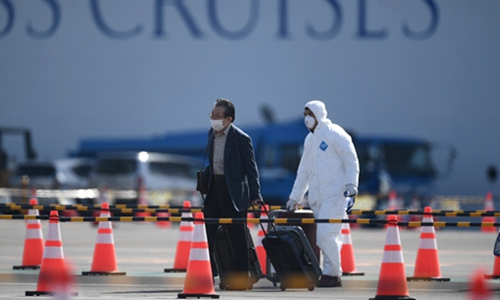HOME >> OPINION
COVID-19: A grey rhino we should have seen coming
By Eiichi Shindo Source:Global Times Published: 2020/2/23 20:08:40

A passenger (left) disembarks from the Diamond Princess cruise ship - in quarantine due to fears of the novel coronavirus - at the Daikoku Pier Cruise Terminal in Yokohama on Wednesday. Photo: AFP
We have been wondering if the novel coronavirus is a black swan or a grey rhino. It broke out in Wuhan, capital of Central China's Hubei Province, late last year and within two months spread to East Asia and even beyond. Now governments and scientists across the world are trying to identify its exact source and looking for ways of countering it.A black swan refers to an incident that's hard to predict and causes chaos like the 9/11 terror attacks or the bursting of the dot-com bubbles in 2000. A grey rhino represents an obvious danger that should have been anticipated but was mostly ignored.
In other words, a black swan comes up unexpectedly with limited damage, while a grey rhino suddenly rushes out of control, resulting in a great deal of damage.
The novel coronavirus could be categorized as a grey rhino as we knew from our experience there was potential for its rise, but little seems to have been done in advance of its coming.
We wonder why we have this attack of the grey rhino in China that is charging across East Asia, and why and how Japan should cooperate with China to tame this dreadful beast.
First, we should recognize the fact that the grey rhino of the coronavirus is a negative byproduct of the rapid economic growth of middle-income countries under the third wave of globalization.
It was brought about by a sharp rise in Asian powers, as the region, led by China, had taken advantage of its large population and huge geographical area.
Eurasia's vast landmass, which once hindered its development, has led to advances in infrastructure construction technology, including solar energy, railroads and highways.
However, the rapidly advancing middle-income countries in Asia have been slow in developing risk management systems in the fields of agricultural-food safety and healthcare.
We wonder why China and others in East Asia seem to have not learned lessons from the SARS outbreak in 2003. Why haven't multilateral institutions been created to ensure the safety of the agricultural-food system? We could learn from the European Union, which in 2002 established the European Food Safety Authority to oversee every aspect of food security from production to marketing. EU regulations cover safe production and import systems.
The grey rhino that is the novel coronavirus reveals the conditions for peace and prosperity in the post-Cold War world - we wouldn't be able to enjoy our individual well-being without having cooperative relations with neighboring countries.
Supply chains, highly advanced technologies and human travel across international borders are the basis of prosperity in the region.
If we look at the interconnected supply chains between China, Japan and Korea, and travelers among the three countries, we see an increasingly important and rapidly developing region.
We have become accustomed to the politico-military security concept based on the European modern state system. The grey rhino of the coronavirus is telling us to define security differently. We should emphasize social-economic fields of cooperation rather than military alliances.
We can now lay out more pragmatic strategies for the China-proposed Belt and Road Initiative and the process of regional community building. This could include establishing an Asia Health Organization, which would help raise awareness of public health crises and help corral any future grey rhinos.
The author is president of International Academic Society for Asian Community. opinion@globaltimes.com.cn
Posted in: ASIAN REVIEW